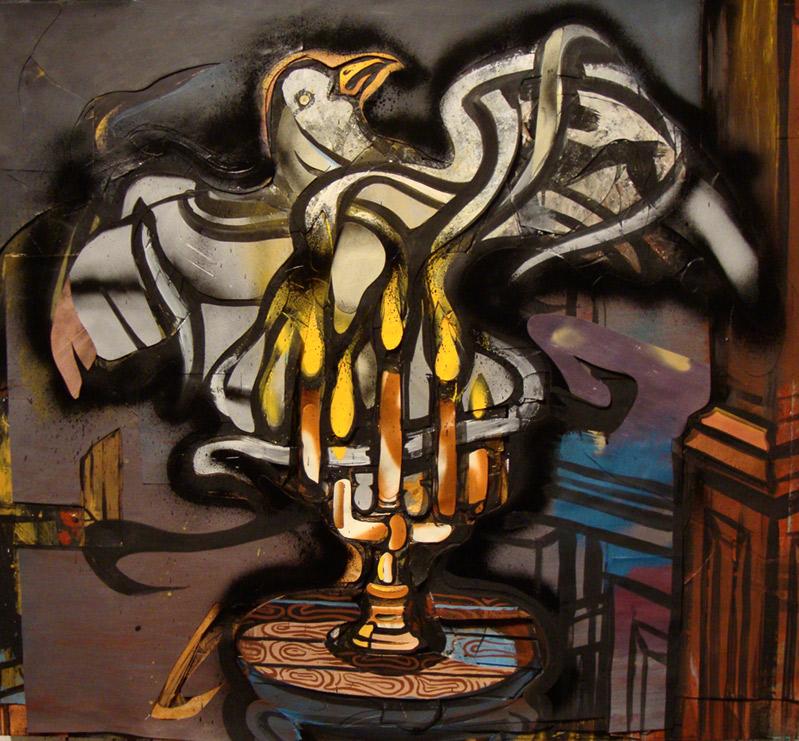Now is the time to think about revisiting all the places we have enjoyed in the warmer weather that are about to vanish in the off-season. One of these treasures is the Arts Center at Duck Creek, which has been showing art on its grounds in Springs and in its galleries since the spring but is due to close on Oct. 16. The center's popular weekend jazz concerts ended a couple of weeks ago, but there are still solo shows by Jesse McCloskey and Sally Richardson in its indoor spaces (and a season-long installation of Wendy Klemperer's sculptures outdoors).
Ms. Richardson's sculptures, made of limestone, marble, and wood, take up most of the floor space of the Little Gallery, the smaller building on the property. It's a more-is-more aesthetic, and it works, as each piece builds on the others rather than taking away from them.
The artist hovers between an abstract and a figurative style, offering hints of grounding naturalism but never settling there for long. A piece like "Oarweed" suggests a bunny, but upon further examination is much more a flight of fancy. Still, the number of "Heads" and "Figures" in her titles gives up the game, their corresponding works offering suggestions of such tangible associations even if attenuated, globular, or flat.
Placed closely together, the pieces appear to form a gathering or party -- sociable and festive in a crowded pre-pandemic way. Aesthetically, the installation offers undeniable associations with images of Brancusi's studio, and Ms. Richardson's forms are loosely informed by his own.
Yet she finds her own path and inspiration; nothing is pure copy. Her forms are softer, often narrower, and flatter. Her use of wood gives those pieces warmth and life. Her choice of materials is determined by found and given objects, resulting in unusual mediums such as cherry, blueberry, mahogany, and totara, a New Zealand wood used for fence posts and reclaimed for many of her sculptures. She often leaves hints of the totara wood's previous utility, with nail holes and other marks remaining. It lends a less precious air and highlights their reclamation.
In a 2009 profile in The Star, Russell Drumm called Ms. Richardson's pieces "organic to the point of breathing." They can seem sentient as well, capable of emotions and even conveying feelings like isolation, ennui, excitement, and love.
Some of that feeling must come from her working methods, as she uses only hand tools to carve her wood and stone pieces, waiting for the figure within to present itself to her. That kind of intimacy with the materials -- be it wood, limestone, or marble -- yields a surface that helps communicate as much as the shapes she conjures.
The forms that emanate can seem human, animal, plant-like, and some even conjure the sea, like a piece from this year titled "Drift." Composed of four distinct small marble slabs that have been carved separately and then placed together on a metal plate plinth, the piece appears to be less about wave action close to the shore and instead the more random rhythms of the sea far beyond the breakers.
Her profound connection to the water has been nurtured from living in Montauk after a childhood on the coast of East Anglia in England. In that region as well as in her family history, the traditions of shipbuilding, fishing, and maritime folklore are strong.
The choices of pedestals for her art are evocative, underlining the salvaged nature of most of her materials, with their casual forms, finishes, and sometimes obvious repurposing. A tree stump, an old wooden crate, an inverted bucket, a roughly painted side table that's been tapped together, or industrial beams, bars, and blocks in rusted metal, concrete, and brick, offer each object placed on them a chance to shine, without becoming bombastic. The bases keep the artworks' subtle and graceful energy in check.

In the barn, Jesse McCloskey's brooding "Night Gallery" exhibition seems seasonally appropriate. Its themes of sex and death came from the artist's isolation working in his studio during Covid-19. But as the East End's fall takes on hints of New England with crunchy fallen leaves and repressed sensibilities brought alive by Halloween, his Massachusetts background also comes to the fore. In this setting, with its unfinished walls and ancient wood, the art feels conjured as if by a witch's spell.
The pieces are made by an accumulation of layered materials on canvas that he cuts into to help deepen their physicality and imagery. His work, like Ms. Richardson's, vacillates between recognizable form and abstraction. But he ends up further down the representational side of the spectrum.
"While the subjects I choose to paint are a constant source of love, desire, and need," Mr. McCloskey has said, "it's the craving of something almost out of sight -- something I can't see until it arrives in the paintings -- that I really want, so I work them until it does. This is how they become heavily layered, excavated, then papered over again and again until the representational and the abstract come together."




